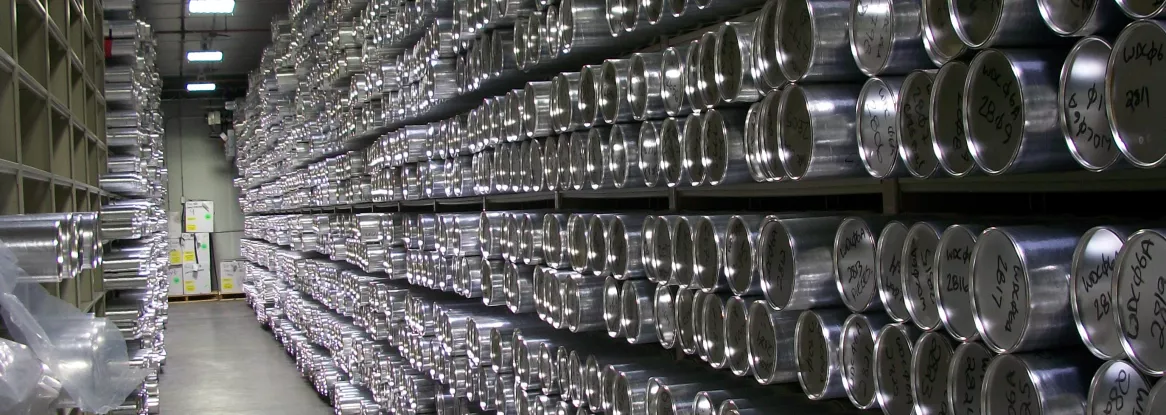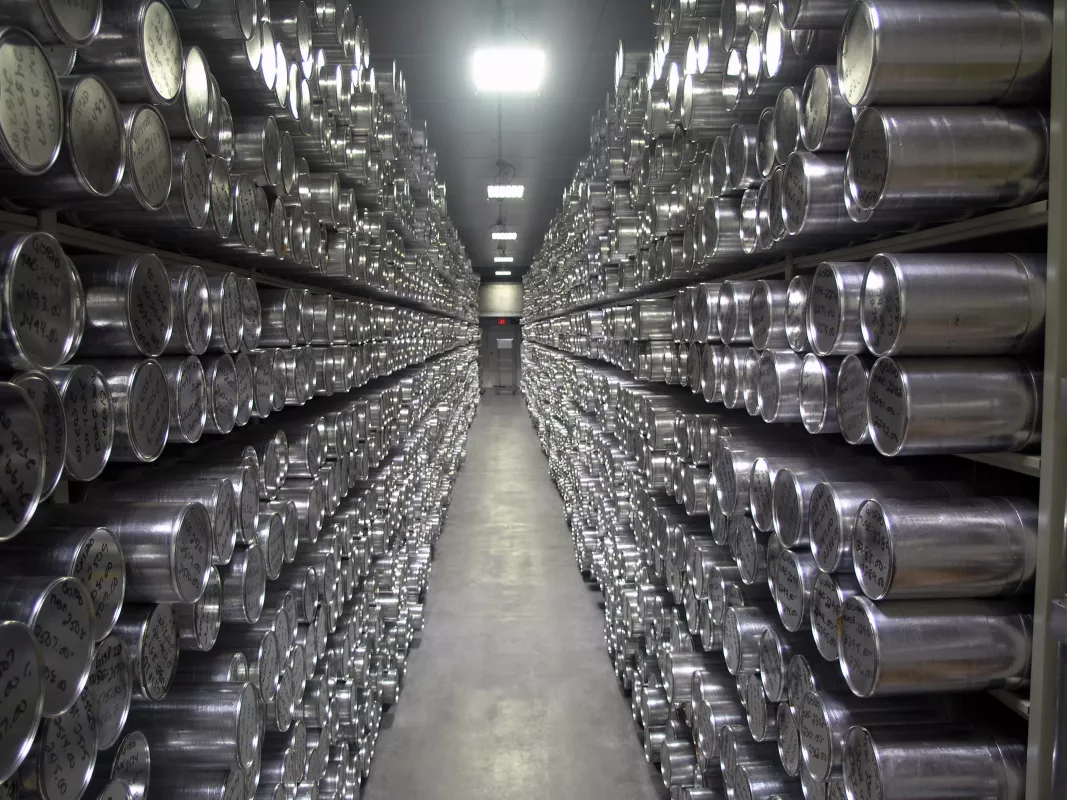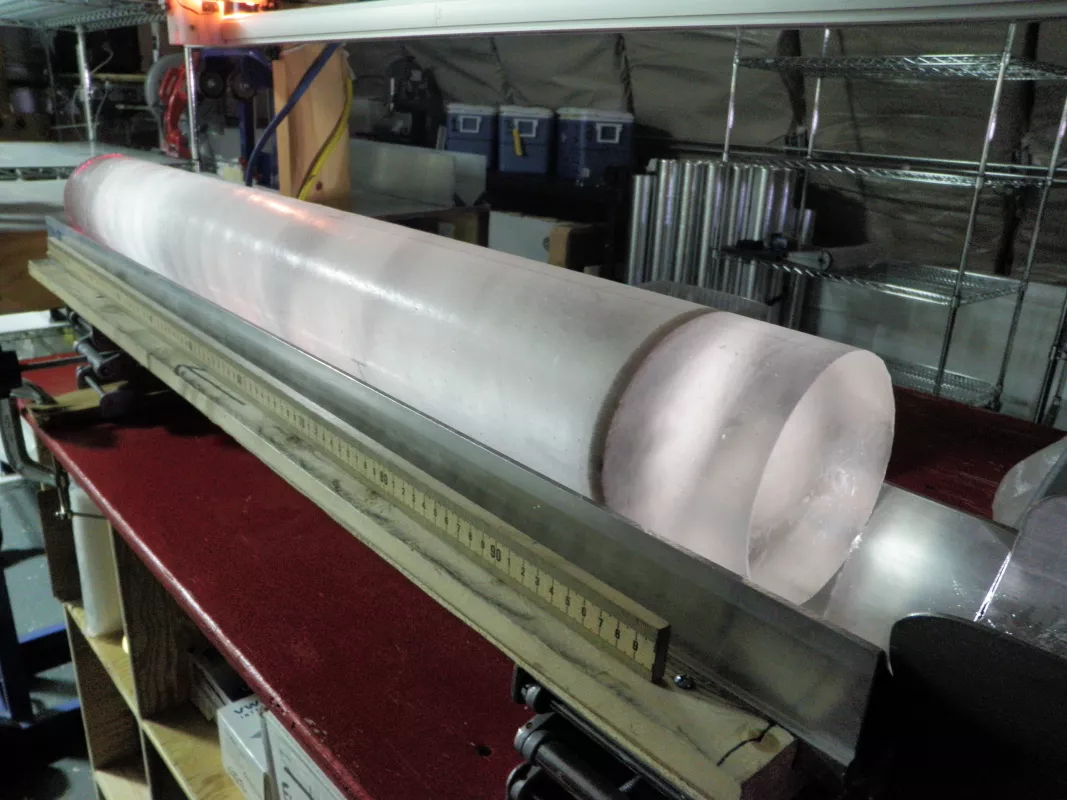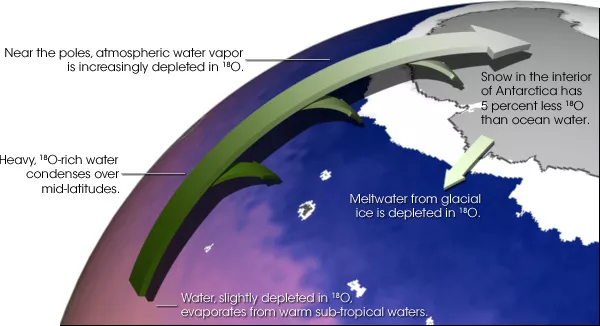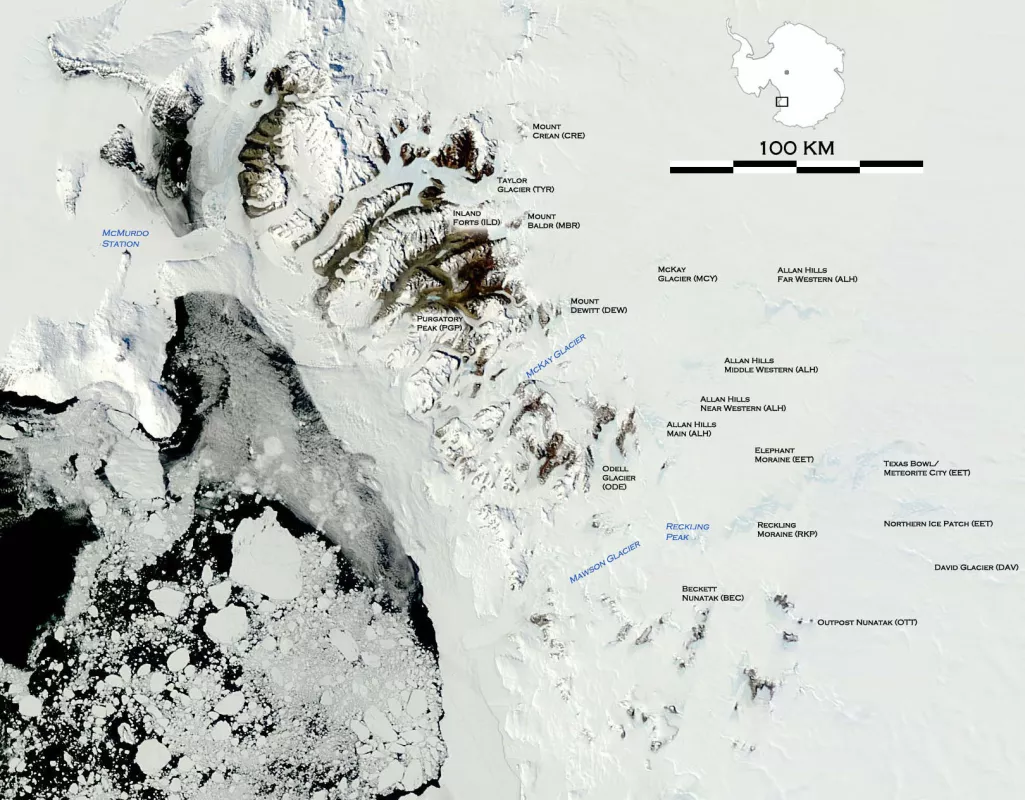By Michon Scott
Scientists often seek clues to past climates by drilling into glaciers and ice sheets. The extracted ice cylinders, sometimes taken from several kilometers below the surface, show evidence of atmospheric composition, volcanic eruptions, dust storms, even wind patterns. Combined with other paleoclimate records such as tree rings and fossils, ice cores enable scientists to reconstruct past worlds.
By preserving evidence of ancient temperatures and greenhouse gases, ice cores show scientists how much our planet has changed. Although the period documented by ice cores is unimaginably long by human standards—up to 800,000 years with isolated older samples as of this writing—it is a very short interval of the planet’s 4.5-billion-year history.
Ice cores help scientists compare atmospheric conditions before and after the Industrial Revolution, when humans began burning large quantities of fossil fuels. Paleoclimate records show how human activity has boosted global temperatures in a very short span of geologic time.
Drilling and storing ice cores
Since the 1960s, scientists have drilled ice cores from the polar regions, North and South America, and Eurasia. Drillers can extract ice cores with either mechanical or thermal drills. Thermal drills are better suited to warmer conditions where it is possible to melt the ice surrounding the core. Mechanical drills are optimal for colder conditions near the centers of ice sheets, places where thermal drills cannot generate enough heat to melt the deep-freeze ice.
Ice cores are generally sliced into segments up to a meter long for transport and storage. Ice core storage requires specialized facilities. The National Science Foundation Ice Core Facility (NSF-ICF) houses ice cores from Greenland, Antarctica, and North America. The NSF-ICF’s main freezer provides 1,600 cubic meters (55,000 cubic feet) of storage space, kept at a frigid -36°C (-33°F). Although the facility has an on-site examination room, most ice analysis is performed offsite, after ice samples have been shipped to other research facilities.
How ice preserves evidence
Over hundreds or thousands of years, unmelted snow accumulates, turning from fluffy powder to hardened ice layers called firn. Weighed down by fresh snow, firn layers compress and densify, first into porous ice and finally into solid, almost transparent ice that forms the core of glaciers and ice sheets. Falling snow often crystallizes around atmospheric particles such as pollen, dust, smoke, or volcanic ash, all of them preserving details about the moment each snowflake fell from the sky. Also, as the firn is compressed, air within the spaces between snow grains is trapped within the ice, preserving a sample of the atmosphere at the time the firn air pockets are sealed off. From those tiny, ancient air pockets, scientists can sample greenhouse gases such as carbon dioxide and methane.
You might not think of snow as a data archive, but it preserves a wealth of information about the past, ranging from landscapes to weather.
Ice-core analysis of volcanic ash indicates how eruptions affected past climates. Volcanic eruptions emit carbon dioxide, ash and other gases and underwater eruptions may warm climate by expelling water high into the atmosphere. But the net effect of most volcanic eruptions is climate cooling. This is especially true of big, sulfur-dioxide-rich eruptions near the equator. Chemical reactions in the atmosphere convert the sulfur dioxide into sunlight-blocking sulfates, sometimes with drastic consequences.
Ice-core analysis of dust or ash particles may reveal their geographic origin. The prevalence of dust in an ice core hints at ancient aridity. Ice-core analysis of pollen yields clues about what types of plant life thrived in ancient environments, while analysis of smoke particles gives clues about the prevalence of wildfires. Ash particles can sometimes be traced back to the volcano from which they erupted.
Ice cores can even offer glimpses into changing seasons and weather events. Multiple cores taken from the same region may show the effect of snowdrifts and tell scientists about wind direction. Round-the-clock summer sunlight tweaks the snow structure in ways a skilled scientist can distinguish from wintertime snow cover.
Ice-core analysis can reveal something else. At its core (pun intended), ice is water, and water has a knack for recording temperature.
Measuring past temperatures with an oxygen thermometer
Water molecules, whether frozen, liquid, or gaseous, contain hydrogen and oxygen atoms—H2O. But oxygen comes in multiple varieties, or isotopes.
An oxygen molecule consists of 8 protons, 8 electrons, and anywhere from 8 to 10 neutrons. If there are only 8 neutrons (16O), the oxygen isotope is “light.” If there are 10 neutrons (18O), the oxygen isotope is “heavy.” Water rich in light oxygen evaporates more easily; water rich in heavy oxygen condenses more quickly.
Moisture-rich air rising into the atmosphere or moving toward the polar regions cools and condenses. Water containing heavy oxygen falls out of the atmosphere faster than water containing light oxygen. Once an air mass reaches a high latitude, it contains fewer heavy oxygen isotopes. So, ice cores extracted from the polar regions reveal past temperatures through the ratio of heavy to light oxygen isotopes. The fewer heavy isotopes in a polar ice core, the lower the ancient temperature.
Spotting human influence with carbon isotopes
Like oxygen, carbon also comes in multiple isotopes. Carbon has 6 protons, and anywhere from 6 to 8 neutrons. Carbon-12 (12C) has 6 neutrons, and carbon-13 (13C) has 7 neutrons. Both are “stable” isotopes that do not decay into other forms. In contrast, radioactive carbon-14 (14C) decays into a stable isotope, with a half-life of roughly 5,700 years.
Carbon-14 results predominantly from the activity of cosmic rays in Earth’s stratosphere, and it is exceedingly rare under all circumstances on Earth. But there is a difference between uncommon and nonexistent, and this difference helps scientists identify the carbon’s source.
Fossil fuels, which have been buried underground for millions of years, are completely devoid of carbon-14; all those atoms have long since decayed away. Burning fossil fuels does two things at once: raises the atmospheric concentration of carbon dioxide and lowers the ratio of carbon-14 in the air by diluting it with “old” carbon.
So, what do ice cores say about carbon?
The NSF-ICF reports that ice cores preserve evidence of much lower levels of atmospheric carbon dioxide than today. Since the start of the Pleistocene Epoch, roughly 2 million years ago, some periods in which glaciers retreated (called glaciations and interglacials) caused massive swings in carbon dioxide. For a period of at least 800,000 years, CO2 concentrations ranged from 180 to 300 parts per million, according to a high-resolution ice-core record from Antarctica.
Since the start of the Industrial Age, however, human-caused greenhouse-gas emissions have steadily raised CO2 concentrations. The National Oceanic and Atmospheric Administration (NOAA) Global Monitoring Laboratory reports that, as of the week beginning February 26, 2023, CO2 emissions stood at 421.91 parts per million.
Compared to ancient atmospheric composition, today’s atmosphere has more carbon dioxide, and that carbon dioxide has a smaller proportion of carbon-14. Both these facts show the effect of human activity and the burning of massive amounts of fossil fuel.
Constantly coring older ice
Interpreting past atmospheres, climates, and landscapes means finding a trusty repository of those data. The further back in time the repository reaches, the better.
Ice-drilling operations usually look for a record of snowfall arranged in neat layers, uninterrupted by glacier flow, with the newest layers on top and the oldest layers on the bottom. Scientists can date the ice through counting layers (like counting tree rings), chemically analyzing ice composition, modeling ice movement, or correlating with other paleoclimate records.
As the NSF states, ice cores show lower carbon dioxide amounts over the past 400,000 years, but ice cores reach back even further in time. According to the NSF-ICF, cores extracted from the Greenland Ice Sheet preserve 130,000 years of climate history. Cores from the Antarctic Ice Sheet preserve up to 800,000 years. Researchers continually strive to extract older ice, so these ice-core-age limits will likely increase.
Traditional ice cores offer a roughly continuous record. But in 2017, an innovative approach sacrificed continuity in favor of older samples, according to Science. Rather than avoiding glacial flows, a team led by Yuzhen Yan at Princeton sought them out, with impressive results. Cores were taken from the Allan Hills Blue Ice Areas in East Antarctica—an area where lateral glacier flow and complex topography in the windswept region pushes ancient ice close to the surface. Yan and colleagues described an ice sample 2.7 million years old. They dated the samples through chemical analysis of argon in air trapped in the ice. The results indicated that carbon dioxide did not exceed 300 parts per million.
Geologic evidence suggests the Antarctic Ice Sheet began forming over 30 million years ago, but that does not mean the earliest ice sheet remnants persist today. Ice sheets advance and retreat over time, and bedrock heat can slowly melt ice from underneath. Even so, future innovations in ice coring in blue ice areas or beneath rocky coverings may yield even older ice samples than those collected to date.
Putting it all together
Paleoclimatology relies on ice cores but also tree rings, cores drilled from lake and ocean sediments, and fossils. Piecing together all the evidence produces a picture of a planet that was often much hotter than today, but was cooler than the present climate for most of the last 11,000 years. Ice cores also show that current carbon dioxide concentrations are now higher than they have been for hundreds of thousands of years, and the higher concentrations are driven by human burning of fossil fuels.
Multiple paleoclimate records indicate cooler temperatures over the past 11,000 years, as shown in this cartoon. Credit: C. Iverson and E. Greenhalgh, NOAA Climate.gov, based on data from doi:10.1126/science.1228026
Even if all emissions stop tomorrow, fossil-fuel-driven warming will continue for a few decades, as deep-ocean heat rises to the surface. Scientists estimate the warming already “in the pipeline” at more than 0.9°F (0.5°C). Of course, emissions will not stop tomorrow, but the sooner fossil-fuel emissions stop or slow, the less temperatures will continue to rise.
Why does this matter? If Earth was warmer for much of its history, why worry about rising temperatures now? After all, 50 million years ago, Earth was so warm, there were no polar ice sheets at all. But 50 million years ago, there were no people, no agriculture, no coastal infrastructure, few of the things we rely upon for our daily lives.
In fact, the entirety of human civilization has played out against a backdrop of remarkable climate stability. Nudging our planet into a warmer climate regime through greenhouse gas emissions could force an unprecedented climate adaptation. Ice cores cannot tell us what the future holds; we must rely on climate projections for that information. But ice cores, combined with other paleoclimate records, reveal how much and how quickly human activity has warmed Earth’s climate. The changes in greenhouse gas concentrations and global temperatures have occurred in less than a few centuries—after more than 100 centuries of stable conditions. Our planet will survive a warmer climate, but unwittingly surrendering climate stability might lead to a precarious future for humanity.
References
Dieter Lüthi, M. Le Floch, B. Bereiter, T. Blunier, J.-M. Barnola, U. Siegenthaler, D. Raynaud, J. Jouzel, H. Fischer, K. Kawamura, and T.F. Stocker. 2008. High-resolution carbon dioxide concentration record 650,000-800,000 years before present. Nature 453: 379-382. https://doi.org/10.1038/nature06949
Ehrmann, W.U., and A. Mackensen. 1992. Sedimentological evidence for the formation of an East Antarctic ice sheet in Eocene/Oligocene time. Palaeogeography, Palaeoclimatology, Palaeoecology (93(1992): 85-112. https://doi.org/10.1016/0031-0182(92)90185-8
Herring, D., and R. Lindsey. 2022. Can we slow or even reverse global warming? NOAA Climate.gov. Accessed March 9, 2023.
Marcott, S.A., J.D. Shakun, P.U. Clark, A.C. Mix. 2013. A reconstruction of regional and global temperature for the past 11,300 years. Science 339(6124): 1198-1201. https://doi.org/10.1126/science.1228026
National Oceanic and Atmospheric Administration. Global Monitoring Laboratory. Accessed March 3, 2023.
National Oceanic and Atmospheric Administration. Global Monitoring Laboratory: Isotopes. Accessed March 9, 2023.
National Oceanic and Atmospheric Administration. Research News: Tracking fossil fuel emissions with carbon-14. Accessed March 9, 2023.
National Science Foundation. National Ice Core Facility. Accessed March 3, 2023.
Reibeek, H. 2005. Paleoclimatology. NASA Earth Observatory. Accessed March 3, 2023.
Scott, M. 2014. What’s the hottest Earth has been “lately”? NOAA Climate.gov. Accessed March 3, 2023.
Sinisalo, A., and J.C. Moore. 2010. Antarctic blue ice areas – towards extracting palaeoclimate information. Antarctic Science 22(2): 99-115. https://doi.org/10.1017/S0954102009990691
Voosen, P. 2017. Record-shattering 2.7-million-year-old ice core reveals start of the ice ages. Science. Accessed March 3, 2023.
Yan, Y., J. Ng, J. Higgins, A. Kurbatov, H. Clifford, N. Spaulding, J. Severinghaus, E. Brook, P. Mayew3ski, and M. Benver. 2017. 2.7-million-year-old ice from Allan Hills Blue Ice Areas, East Antarctica reveals climate snapshots since early Pleistocene. Goldschmidt Conference. https://goldschmidt.info/2017/abstracts/abstractView?id=2017004920
